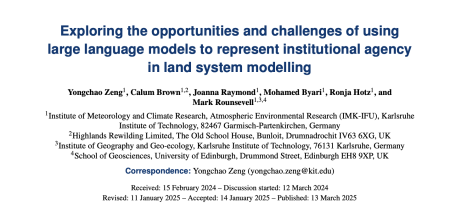
Resource description:
Institutional agencies play a crucial role in land use change, but modelling their decision-making processes is challenging due to the complexity of the environment they operate within and the bounded rationality of human organizations. Large Language Models (LLMs) offer a novel approach to simulating human decisions. This paper aims to investigate the challenges and opportunities that LLMs bring to land use change modelling by integrating LLM-powered institutional agents with the CRAFTY land use model, in which land users produce a range of ecosystem services. The study develops a structured prompt development approach for coupling LLM-powered agents with existing large-scale simulations. Four types of LLM-powered agents are examined, which use taxes to steer meat production toward a prescribed policy goal. The agents provide reasoning and policy action output in each simulation iteration. The study also uses a technique called quasi-multi-agent to simulate multiple roles involved in the policy processes. Unlike authentic multi-agent simulation, the LLM-powered quasi-multi-agent leverages the LLM's ability to generate contextually coherent text and allows the agents to work as a scriptwriter who composes conversations between different roles. This approach conserves computational resources and has the potential to manage conversational dynamics in policy discussions. The efficacy of these agents is benchmarked against two baseline scenarios: one without any policy intervention and another implementing optimal policy actions determined through a genetic algorithm.
Author/Contact:
Yongchao Zeng, Calum Brown, Mohamed Byari, Joanna Raymond, Ronja Hotz, and Mark Rounsevell